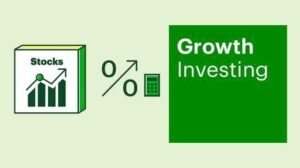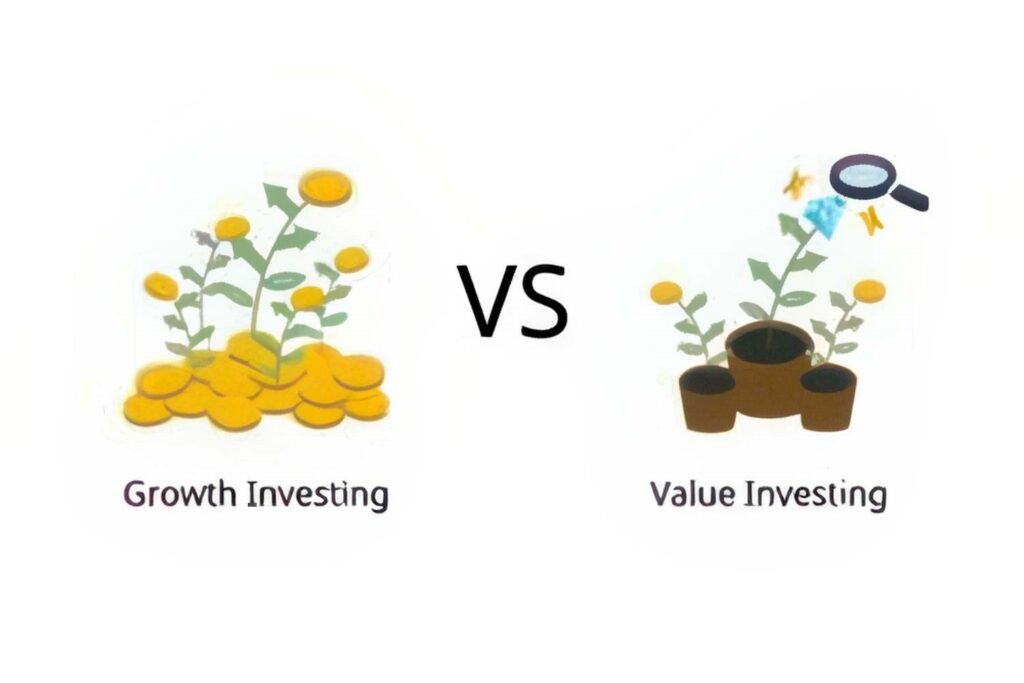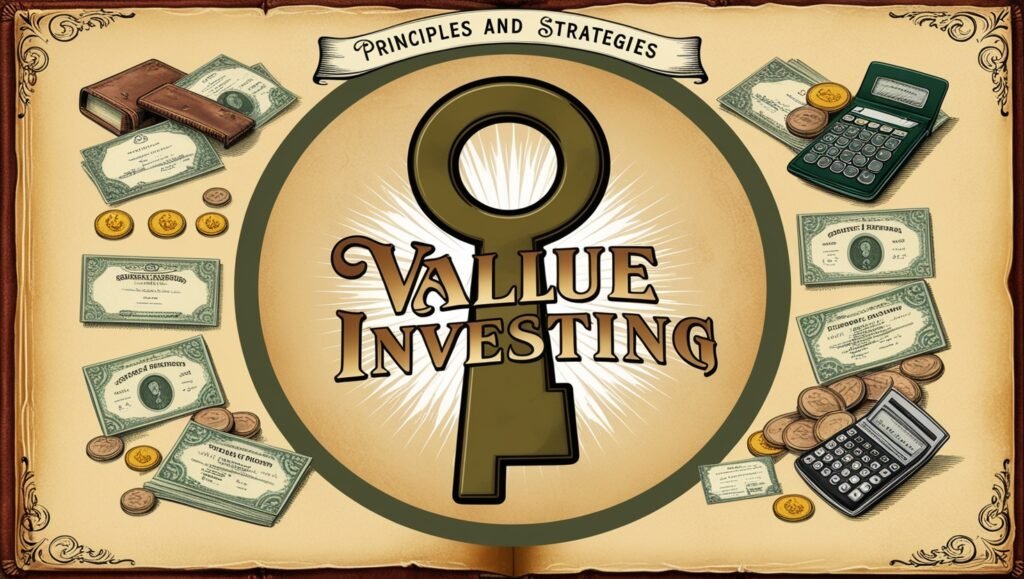Are you ready to invest but unsure which strategy to choose? The decision between value investing and growth investing has a major effect on your portfolio’s performance and risk profile. This blog post will explore both approaches in depth and help you to understand their characteristics, advantages and drawbacks.
By the end, you’ll have a clear understanding of growth and value investing, enabling you to make right decisions according to your financial goals and risk tolerance. Let’s start
What is Growth Investing?

Growth investing focuses to find companies that have high growth potential. This strategy prioritizes revenue growth and future earnings instead of current dividends or valuations. Growth investors seek out businesses expected to grow faster than market or industry averages.
Growth stocks usually have higher price-to-earnings (P/E) ratios, since investors will pay extra for anticipated future growth. These companies usually reinvest profits to fuel expansion rather than pay dividends.
You’ll see growth investing specially common in sectors such as emerging industries, technology and biotechnology where innovation drives rapid growth.
Pros of Growth Investing
Growth investing has many benefits for those seeking high returns:
- Possible substantial profits as fast-growing companies’ stock prices can change
- Exposure to disruptive businesses and innovative which shape industry futures
- Chance to capitalize on developing market trends and technological advancements
- Strong performance during bull markets and economic booms
Cons of Growth Investing
Despite potential advantages, growth investing has some disadvantages:
- More volatility with significant stock price changes
- Risk stocks become overvalued due to optimistic future guesses
- Sensitivity to market sentiment and economic conditions
- Bigger losses possible during market declines or slow growth periods
What is Value Investing?

Value investing means finding undervalued companies with strong fundamentals. Unlike growth investing, this approach stresses current financials and intrinsic value over future growth potential. Value investors look for stocks trading below their true worth that are usually shown by lower P/E ratios.
This strategy believes the market sometimes incorrectly prices stocks and makes chances to buy quality companies at a discount. Value investors focus on businesses with solid balance sheets, strong cash flows and steady earnings, even if the market currently doesn’t favor them.
Pros of Value Investing
Value investing has many advantages for patient investors:
- Possible steady and long-term returns as undervalued stocks reach their true value
- Less volatility versus growth stocks which involves smooth investment strategy
- A safety margin due to the emphasis on undervalued companies with strong fundamentals
- Better performance during market bearish, as these stocks already have conservative pricing
Cons of Value Investing
While value investing has merits, it also has minuses:
- Potential underperformance during bull markets when growth stocks often skyrocket
- Risk of falling into “value traps” where seemingly undervalued stocks keep declining
- Requires patience and thorough analysis, which can be time-consuming and tough
- May lag during times of fast technological innovation or economic growth
Key Differences Between Growth and Value Investing

After covering the fundamentals of growth and value investing, let’s discuss the key differences. Understanding these contrasts will help investors to make right investing decisions.
Investment Focus
Growth investors target high-growth potential companies usually in new or innovative industries. These firms should grow rapidly, beating market averages. Value investors seek undervalued firms with strong fundamentals usually in developed sectors.
They look for underpriced stocks, believing the market missed their true potential.
Primary Goals
Growth investing aims for long-term capital appreciation. Investors hope to benefit from major stock price increases as companies grow. Value investing focuses on capital preservation and income.
These investors want steady returns and often prioritize dividend-paying stocks which provide regular income and potential price gains.
Valuation Metrics
When comparing growth investing and value investing one key difference lies in their valuation metrics. Growth stocks usually have higher Price-to-Earnings (P/E) ratios, sometimes 50 or more for fast-growing companies. This shows investors pay extra for future growth potential.
Value stocks have lower P/E ratios, usually below market averages. Value investors focus on potential future returns and undervaluation.
Dividends
Growth companies often reinvest profits to expand their business rather than paying dividends to the shareholders. This aims for higher returns from stock price rises. Value stocks frequently pay dividends. Many value investors want consistent dividend history and they consider it as a source of regular income and financial stability.
Risk Tolerance
Growth investing requires more risk tolerance. These stocks can wildly fluctuate on the basis of company performance or market trend. Value appeals to lower risk tolerance. While not risk-free, value stocks tend to be more stable with lower valuations cushioning against downturns.
Time Horizon
Growth investors take a long-term view and accept short-term volatility for later big returns. They may hold for years or decades. Value investors are also usually long-term focused but may have a shorter time horizon. They may sell when stock reaches true value or better opportunity comes.
Market Perception
Growth stocks generally enjoy optimism and high expectations. Investors are excited about their potential and pay premiums. While, value stocks face lower expectations which are overlooked or out of favor stocks creating chances for value investors who see mispricing.
Characteristics of Growth Stocks vs Value Stocks
Let’s examine the specific qualities of growth and value stocks. Understanding these characteristics will help to identify potential opportunities.
Growth Stocks

Growth stocks come from fast growing companies expected to outperform market averages. They usually perform in innovative or high-technological industries such as emerging sectors, biotech or technology. Growth stocks tend to have higher volatility and stock prices change on the basis of market trends and company performance.
For example, Amazon, Netflix and Tesla are growth stocks. They have shown exceptional development and keep reinvesting profits into more innovation and growth. Investors in these stocks often pay higher prices betting on future potential growth.
Value Stocks

Value stocks come from developed companies that are potentially undervalued by the market. They operate in traditional sectors like consumer goods, finance or energy. Value stocks usually have lower volatility since they have strong fundamentals and steady cash flows.
Coca-Cola, Johnson & Johnson and Procter & Gamble are examples of value stocks. They have stable earnings, proven track records and pay regular dividends. Value stocks are usually considered as safer, specially during downturns.
Performance Comparison

Comparing growth investing and value investing strategies over time shows interesting trends across different market cycles. Let’s explore their historical performance and effect of different economic conditions.
Historical Performance
The long-term performance of growth vs value investing has changed over different periods. Historically, value stocks have usually outperformed growth stocks over extended time frames.
However, in recent years, growth stocks have shown strong performance, particularly in the technology sector. It’s important to note that past performance doesn’t guarantee future results and the relative success of each strategy can change over time
Market Cycles
The economy affects growth and value stocks:
- Bull markets & expansions: Growth stocks typically outperform as investors pay more for future earnings.
- Bear markets & downturns: Value stocks often do better since lower valuations cushion against volatility.
Understanding these patterns helps adjust your investment strategy on the basis of market conditions.
Which Strategy is Better?
When comparing growth investing and value investing it’s important to understand that neither strategy is inherently superior. The effectiveness of each approach depends on various factors and individual circumstances.
Let’s explore the key considerations and a balanced approach to help investors make right investment decisions.
Factors to Consider
It’s very important to assess different significant factors before selecting between growth and value investing. Consider the following:
- Goals – Rapid growth or steady income?
- Risk tolerance – Can you handle volatility?
- Timeframe – Short or long-term investment?
- Market conditions – What aligns with economic trends?
These factors play a significant role to determine which technique may be more suitable for your investment strategy.
Blended Approach
Rather than selecting strictly between growth and value investing, many investors chose a blended approach. They combine growth and value investing for:
- Leveraging both strengths
- Mitigating risks
- Smoothing returns over time
- Capturing opportunities in both
A blended strategy might involve high-growth technology and established dividend payers to get potential high returns and stability.
How to Implement Each Strategy
Now that you know the differences between growth and value investing, let’s look at how to use each strategy.
Growth Investing Approach
To use a growth investment strategy:
- Focus on high growth potential companies
- Find businesses with strong revenue and earnings growth above industry averages
- Check key metrics such as ROE, EPS growth and sales growth
- Consider innovative sectors or disruptive products/services
- Accept potential volatility, as growth stocks generally have higher valuations
Value Investing Approach
When using a value investing approach:
- Search for undervalued stocks with strong fundamentals
- Look for companies trading below intrinsic value
- Check ratios like P/E, debt-to-equity and P/B
- Consider stable earners in traditional industries
- Be patient for the market to see the stock’s true value
Conclusion
In comparing growth investing and value investing, we’ve seen that both strategies have significant merits and drawbacks. Your choice depends on your financial goals, risk tolerance and market conditions. Growth investing provides high but volatile returns. Value investing provides more stability but slower growth.
Many successful investors blend both of these approaches to balance their portfolios. Remember, investing isn’t just numbers to make right decisions, also consider qualitative factors.
To learn more about these important aspects, review our blog post on “Buy and Hold vs Active Trading Strategies” a guide to make better investment decisions.


